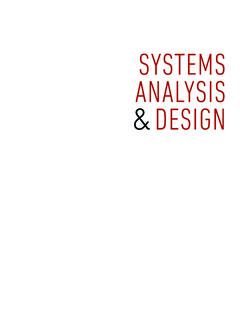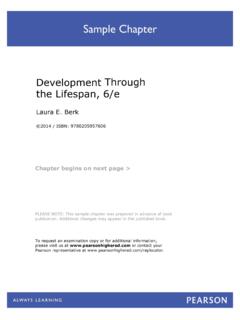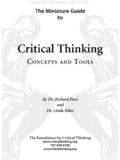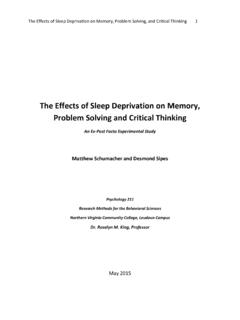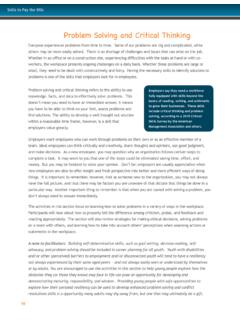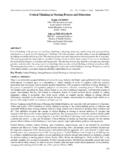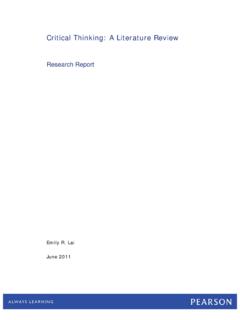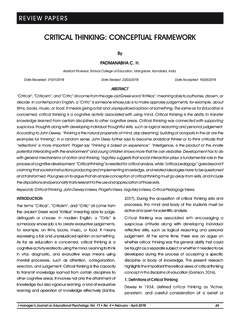Transcription of Chapter 1 What Is Critical Thinking? - Pearson
1 Chapter 1 what Is Critical Thinking? 1 Often, a good way to begin the process of thinkingcritically about a subject is to do some conscious thinking about itbeforeyou do any reading or hear any presentations in the , if you are going to study biology or sociology or writing, a goodway to begin is by writing down some of the main ideas you alreadyhave about biology or sociology or writing itself beforeyou do anyreading or listen to lectures. This allows you to be an active listenerrather than a passive recipient of information. It helps you to becomeaware of your assumptions about the subject so that you can assessthem more accurately in light of what you will later read and Definitions of Critical ThinkingHere are three definitions of Critical thinking by leading , Robert Ennis s classic definition:1 Critical thinking is reasonable, reflective thinking that is focused on decid-ing what to believe or 11/29/07 11:45 AM Page 12 Chapter 1 Even before you start reading this text, begin by examining your own con-cept of Critical thinking .
2 Before you start reading this text, respond to thefollowing in a paragraph or is your concept of Critical Thinking? You can respond to question(1) by giving a description. An alternative way to address it, though,is to use a situation in which you thought through something a situation in which you did not think through write a paragraph describing how, in your best judgment, criticalthinking is necessary within the subject matter you are , Matthew Lipman s definition:2 Critical thinking is skillful, responsible thinking that is conducive to good judg-ment because it is sensitive to context, relies on criteria, and is , in informal presentations, Richard Paul uses this definition: Critical thinking is thinking about your thinking , while you re thinking , inorder to make your thinking of these is an excellent def-inition of Critical thinking . It paysto read them several times and tostop and reflect on every aspect ofeach definition. Why did the expertinclude this word rather thananother?
3 Just what are the expertstrying to capture with the wordsthey have chosen? what overlap isthere in the definitions, and whatmain differences of emphasis arethere?It may seem hard to believe, buteach of these definitions, brief asRevise your concept of criti-cal thinking over the courseof the semester. Reformulateit (maybe scrapping itentirely and starting over)so that it accords with yourdeepening grasp of whatcritical thinking 11/29/07 11:45 AM Page 2 what IS Critical Thinking? 3they are, is the product of a long period of intense pondering abouthow best to describe Critical thinking . Each definition is an attemptto convey in words the essence of an activity, a thing Critical think-ing. Before trying to define it, each expert had an intuitive grasp ofwhat Critical thinking is, based on years of working with it. This waswhat the experts tried to capture in the words they in reading the experts definitions and in the discussion ahead,one very important goal to keep in mind is for you to develop a solidintuitive grasp of just what Critical thinking is and what it is Prominent Features of Critical ThinkingCritical thinking Is ReflectiveCritical thinking is different from just thinking .
4 It is metacognitive itinvolves thinking about your thinking . If I enter a social studies coursewhere one of the topics to be studied is conformity, it is likely that Ialready have views about conformity: what it is, how prevalent it is, what influences people to conform or not conform. I have these viewseven if I haven t formulated them explicitly for myself. Each view is anexample of thinking , but not necessarily an example of Critical think-ing. Critical thinking starts once I reflect on my thinking : Why do Ihave these views about conformity? Since my views are really conclu-sions I have drawn, what evidence are they based on? How do otherpeople look at conformity differently? what are their views based on?How can I tell which are more accurate, their views or mine? Critical thinking Involves StandardsCritical thinking involves having my thinking measure up to can think about something accurately or inaccurately. I can use evi-dence that is relevant to an issue or irrelevant, or somewhere inbetween.
5 When I reason out and try to understand the main ideas ina course I m taking, I can do so on a superficial level or I can try tounderstand them deeply, trying to get at the heart of the , relevance, and depth are examples of standards or cri-teria. The words criticaland criteriacome from the same root,meaning judgment. For my thinking to be criticalthinking, I haveto make judgments that meet criteria of thinking Is AuthenticCritical thinking , at its heart, is thinking about real you can reason out puzzles and brain-teasers, the essence 11/29/07 11:45 AM Page 34 Chapter 1critical thinking comes into play only when you address real prob-lems and questions rather than artificial ones. Critical thinking is farmore about what you actually believe or do. It is about good judg-ment. Puzzles and narrow problems may help occasionally when youwant to hone or practice special skills, but even those skills help onlyif you consciously transfer them to real-life settings.
6 Honing yourskills at guessing the endings of murder mysteries is not likely to begood preparation for becoming a criminal investigator. In murdermysteries, all the clues are provided, the murderer is one of the char-acters, and someone (the author) already knows the murderer sidentity. None of that is so in a criminal problems are often messy. They have loose ends. They areusually unclear: clarifying and refining them are part of thinkingthrough them. They often have no single right answer. But there arewrong answers, even disastrous answers: there may not be any uniqueright person to take as your partner in life, but there are certainlypeople it would be disastrous to PROBLEMSTo get the feel of authentic problems (in contrast to school problems ),think of good novels you have read, or plays or movies you have seen.(Exclude contrived movies where everything automatically works out accord-ing to a formula.) Now consider the problems that are facing some will likely be authenticproblems.
7 They are full of complications andother people s cross-purposes; actions don t work out exactly as planned;emotions and desires are heavily involved in the decisions people an example or two like that, and try to reason through decisionsthat the character could thinking Involves Being ReasonableThere are no surefire rules of reasoning. That is, no rules are so fool-proof that they guarantee your reasoning will be successful. There areguidelines, even rules sometimes, but these always need to be fol-lowed thoughtfully, not by rote. You need to apply them withsensitivity to context, goals, practical limitations a whole host ofrealities. For thinking to be Critical thinking , it must be 11/29/07 11:45 AM Page 4 what IS Critical Thinking? 5 Compare Critical thinking to driving a car. There are rules for gooddriving ( , merge when entering an interstate), but merely followingthe rules won t make you a good driver. To be a good driver you haveto follow the rules mindfully.
8 what does that mean? It means, for exam-ple, following the rules while being aware that the purpose of mergingis to allow traffic to flow more smoothly and reduce collisions betweenfast- and slow-moving cars, that weather and traffic conditions affecthow you should merge, and so on. Notice that this is an open-endedlist of what a mindful driver is aware of while often long for surefire, step-by-step procedures, and the morepersonally important or threatening a situation is, the more we wantfoolproof rules. But there are no rules that guarantee our thinkingwill be correct and that is especially true in very important orthreatening situations. There are no rules to tell us if our reasoningis correct, precisely because we must use our reasoning to evaluaterules, rather than vice versa. The only way we can decide whether tofollow certain rules is if we use our best reasoning to determine thatthose rules are reasonable, that they lead to reasonable results whenfollowed.
9 Critical thinking is self-correcting at least partly becauseit is the court of last resort. There is no level of greater certaintybeneath it that we can use to evaluate our Parts of Critical ThinkingFull-fledged Critical thinking involves three parts. First, criticalthinking involves asking questions. It involves asking questionsthat need to be asked, asking good questions, questions that go to theheart of the matter. Critical thinking involves noticingthat there arequestions that need to be , Critical thinking involves trying to answer thosequestions by reasoning them out. Reasoning out answers to ques-tions is different from other ways of answering questions. It isdifferent from giving an answer we have always taken for granted butnever thought about. It is different from answering impressionisti-cally ( That reminds me of .. ), or answering simply according tothe way we were raised, or answering in accordance with our per-sonality.
10 It is also different from answering by saying the first thingthat comes into our mind, and then using all our power of reasoningto defend that , Critical thinking involves believing the results of ourreasoning. Critical thinking is different from just engaging in a men-tal exercise. When we think through an issue critically, we internalizethe results. We don t give merely verbal agreement: we actually believethe results because we have done our best to reason the issue out 11/29/07 11:45 AM Page 56 Chapter 1we know that reasoning things out is the best way to get reliableanswers. Furthermore, when we think critically through a decisionabout what to do in a situation, then what follows the reasoning isnot just belief, but action: Unless something unforeseen occurs, weend up taking the action we concluded was most the QuestionsCritical thinking begins with asking questions. If a teacher assigns ahomework problem to solve, a good question to ask is How can I bestsolve this problem ?





